Today’s cattle business is way more than cowboys
Cattle ranching is alive and well in the United States, but it looks a lot different than it did two or three decades ago.
Every Wednesday at noon, in Bastrop, Texas, a lot of young steers are at the Hills Prairie Livestock Auction, getting ready for the feed lot. The scene feels a little bit like a miniature rodeo. Cattlemen sit in the balcony and watch the steers waltz back and forth on the stage. When Clint McDonald isn’t auctioning off the cattle, he’s out in the hall running his hand along a screen projecting the futures market.
A cow being auctioned at Hills Prairie Livestock.
“This is the board, the cattle futures board,” he said. “And that’s what everybody’s looking at. And when the board goes down, the cattle go down.”
It’s easy to forget that for all the belt buckles, boots and cowboy hats, these men and women are commodities traders.
Jarad Milton’s family has owned about 800 acres in Bastrop County since World War I. He’s worked cattle on the land for more than 40 years. Some of the time, though, he said, he feels like he’s in Las Vegas.
“You can take a $20,000 risk and turn it into a $2,000 risk,” he said. “You can afford to play the game a little bit. I caught several of the market turns and, you know, made some money every now and again. I paid for the truck and that sort of thing and it was a lot of fun. But it’s not something that works all the time. You really got to be a student of the market.”
A student of the market and a student of many other things. That’s what Jeff Geider would argue. Geider, director of the Institute of Ranch Management at Texas Christian University, said his students study soil and water conservation and ranch finance. There’s even a class on marketing livestock and meat.
“It’s how to blend the economical and ecological aspects of land stewardship,” he said. “Not just in ranching and farming, but in managing all natural resources.”
A lot of Geider’s students come from farm and ranch families. But more and more are new to the industry and are treating it like business school. He said that’s a good thing, because back at the Hills Prairie auction those young cattle are being bid on by a lot of old men.
Cowboys being cowboys. (Andy Uhler/Marketplace)
“Most of the people on these farms and ranches are in their 50s, 60s and 70s,” Geider said. “There’s a huge void of people that are going to come in and operate and take over those businesses. It’s an absolute statement to the industry of where we are today. There’s very little middle ground, if you will. There’s young people and there’s old people.”
There’s at least one example of this age disparity at the auction in the form of Shelley Crenshaw and her young granddaughter.
“Pretty much every Wednesday, we come and hang out and eat lunch and watch the cows go through,” Crenshaw said. “My granddaughter loves to come.”
Crenshaw’s not in the cattle business. She runs what she calls a one-cow operation. She found a calf on her five acres in Bastrop that had lost its mother and decided to take care of it.
Andy Uhler/Marketplace
“If you would have asked me 10 years ago, a city girl like me bottle feeding baby calves, I would have told you you were crazy,” she said.
There’s no telling whether Crenshaw’s granddaughter will catch the bug and want to get into the cattle business.
The situation is a little different for Jarad Milton. He never got married and doesn’t have grandchildren to leave his ranch to. He’s 65, but says he’s not ready to sell off his land just yet.
“You know, why would I try to go and make more money and give this up when all I have to do is stay here and work it and I have this?” he asked. “And why would I work except to come back out here? You know, in a way that’s what makes America work is the chance that every now and then, you can really make some money if you’re doing something.”
These days in the cattle business, “doing something” still means getting out on the land to dig post holes and mend fences. But it also means pulling out your phone to check the latest cattle futures and beef prices.
There’s a lot happening in the world. Through it all, Marketplace is here for you.
You rely on Marketplace to break down the world’s events and tell you how it affects you in a fact-based, approachable way. We rely on your financial support to keep making that possible.
Your donation today powers the independent journalism that you rely on. For just $5/month, you can help sustain Marketplace so we can keep reporting on the things that matter to you.


















